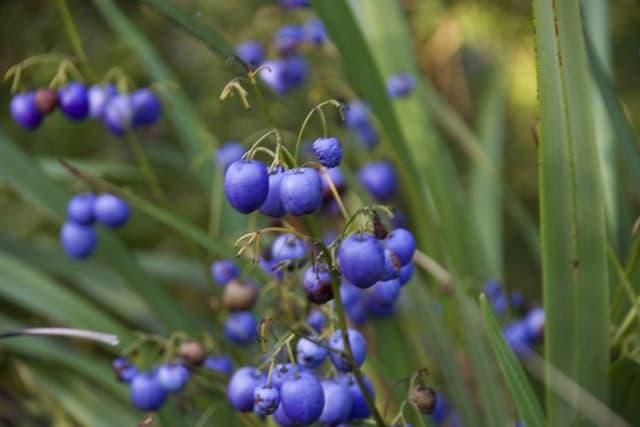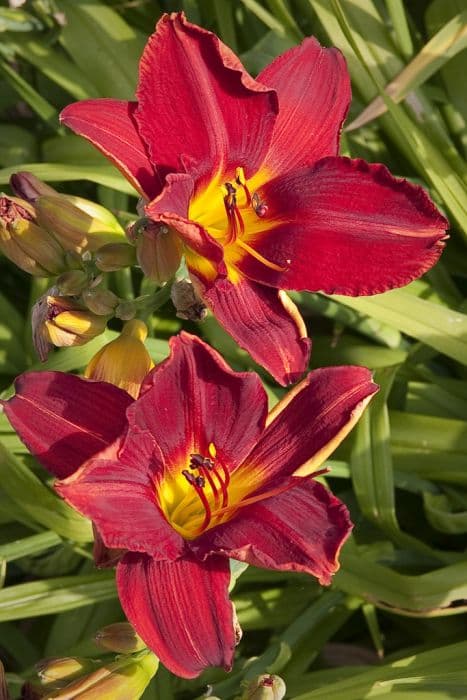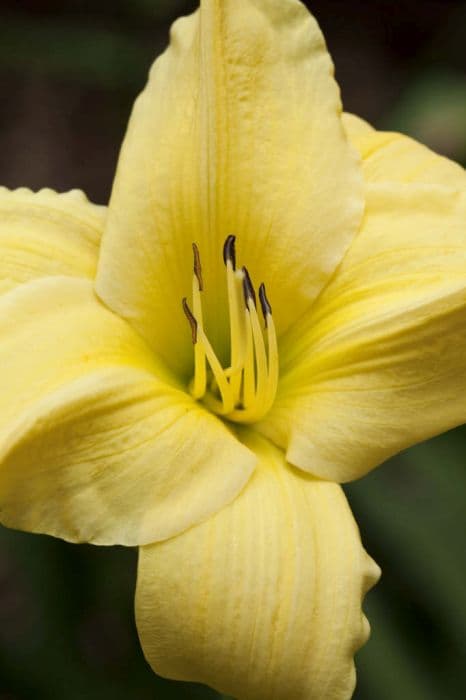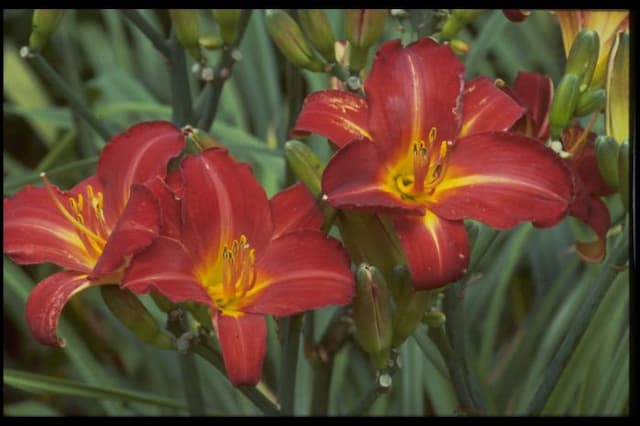Daylily Hemerocallis 'Berlin Red Velvet'

ABOUT
Hemerocallis 'Berlin Red Velvet', commonly known as the daylily, is a striking perennial favorite among gardeners. This cultivar is particularly noted for its luxurious deep red flowers, which possess a velvety sheen, making them appear as if they are illuminated from within. Each bloom comprises six broad petals that often exhibit a slight ruffling along the edges, adding to their rich texture. The flowers of 'Berlin Red Velvet' are characterized by their bright golden-yellow throats, forming an eye-catching contrast against the red petals. These throats also display a subtle merging of colors, with the red bleeding into the yellow in a delicate gradation that adds depth to the overall floral display. The blooms are held aloft on sturdy, arching scapes that rise above the foliage. Supporting the flowers is a mound of long, strap-like leaves that are lush green in color. The foliage forms a dense clump, creating an attractive backdrop for the radiant blooms. The leaves curve gracefully, reaching outwards from the base of the plant, and their texture is somewhat smooth with a slight ribbing, typical of daylilies. The splendor of the 'Berlin Red Velvet' daylily's flowers is fleeting, as each individual blossom typically lasts only a day. However, the plant compensates by producing a succession of blooms over a period of weeks, ensuring a long-lasting display of color in the garden. This daylily's showy appearance makes it a splendid choice for ornamental purposes in various garden settings.
About this plant
 Names
NamesSynonyms
Daylily, Berlin Red Velvet Daylily
Common names
Hemerocallis 'Berlin Red Velvet'.
 Toxicity
ToxicityTo humans
The Hemerocallis 'Berlin Red Velvet', commonly known as daylily, is generally considered non-toxic to humans. In fact, certain parts of the daylily are edible and are consumed in some cultures. However, it is important to note that individuals may have varying sensitivities and may experience mild stomach upset if they consume any part of the plant that they are not accustomed to. Always exercise caution and consult with a professional if unsure about the edibility of specific plants.
To pets
The daylily is known to be potentially toxic to cats, with ingestion potentially leading to symptoms such as vomiting, lethargy, and loss of appetite. In severe cases, daylily consumption can lead to kidney failure in cats. It is important for cat owners to keep daylilies out of reach and to seek veterinary care immediately if they suspect their cat has ingested any part of the plant. In dogs, daylilies are generally not considered toxic, but individual sensitivities can vary, and mild gastrointestinal upset cannot be ruled out. Therefore, it is still wise to prevent dogs from ingesting daylilies.
 Characteristics
CharacteristicsLife cycle
Perennials
Foliage type
Deciduous
Color of leaves
Green
Flower color
Red
Height
2 feet (60 cm)
Spread
2 feet (60 cm)
Plant type
Herb
Hardiness zones
3
Native area
Asia
Benefits
 General Benefits
General Benefits- Easy to grow: Hemerocallis, commonly known as Daylily, is adaptable and can thrive in a variety of soil conditions and climates, making it suitable for many gardens.
- Drought tolerance: Daylilies are known for being drought-tolerant once established, requiring less water than many other garden plants.
- Low maintenance: They require minimal care, making them ideal for gardeners who want a beautiful garden without the intensive labor.
- Long blooming period: Daylilies have a long flowering period, with blooms often lasting several weeks throughout the summer months.
- Attracts pollinators: The bright flowers of the Daylily attract butterflies, bees, and other beneficial pollinators to the garden.
- Variety of colors and forms: Daylilies come in a wide range of colors and shapes, adding visual interest and variety to landscaping.
- Curb appeal: Their vibrant blooms and lush foliage enhance the aesthetic appeal of any property, therefore increasing its curb appeal.
- Erosion control: The root system of Daylilies can help prevent soil erosion on slopes and in areas prone to this problem.
- Edible parts: Some varieties of Daylilies have edible flowers and tubers, adding an element of practicality besides their ornamental value.
- Propagation and division: Daylilies can be easily propagated by division, allowing gardeners to expand their collection or share with others.
 Medical Properties
Medical PropertiesThis plant is not used for medical purposes.
 Air-purifying Qualities
Air-purifying QualitiesThis plant is not specifically known for air purifying qualities.
 Other Uses
Other Uses- The Daylily 'Berlin Red Velvet' can be used as a natural dye for fabrics, yielding a range of colors from soft yellows to deep golds depending on the mordant used.
- Its fibrous roots can be included in compost piles to enhance nutrient content and improve compost structure.
- Daylilies are sometimes planted in areas prone to soil erosion, as their dense root systems help to stabilize the soil.
- The plant can be used in phytoremediation efforts to recover and rehabilitate polluted soils, as some daylilies can absorb toxins.
- Daylily leaves can be woven into baskets or other forms of handicrafts due to their length and fibrous nature.
- The flower's dried petals are often used in potpourri mixes to add a pop of color and subtle fragrance.
- The thick clumps formed by daylilies make them suitable as privacy screens or hedges in landscaping projects.
- Daylily plants are used in water gardens and ponds as marginal plants because they can tolerate damp soils.
- Enthusiasts of the Daylily 'Berlin Red Velvet' might grow them for competitive showing in horticultural shows and fairs.
- The bloom of the daylily can serve as a natural pest control by attracting beneficial insects that prey on garden pests.
Interesting Facts
 Feng Shui
Feng ShuiThe Daylily is not used in Feng Shui practice.
 Zodiac Sign Compitability
Zodiac Sign CompitabilityThe Daylily is not used in astrology practice.
 Plant Symbolism
Plant Symbolism- Daylily (Berlin Red Velvet): The daylily, commonly known for its beautiful but short-lived blossoms, often symbolizes the fleeting nature of life and beauty. Each bloom typically lasts for just one day, reminding us to cherish every moment.
- Carpe Diem: Due to its short bloom time, the daylily can represent the phrase "seize the day," encouraging us to take advantage of the opportunities we have right now.
- Motherhood: In Chinese culture, daylilies are often associated with motherhood and the devotion mothers have for their children, as the plant is able to produce a multitude of flowers over its blooming period.
- Forgetfulness: In the language of flowers, or floriography, the daylily can sometimes symbolize forgetfulness or a loss of memory, possibly because each flower is quickly replaced by another.
- Coquetry: Historically, the daylily has been linked to flirtation or light-hearted romantic encounters, perhaps because its bloom is here today and gone tomorrow, just like a brief, flirtatious moment.
 Water
WaterThe Daylily, which is the common name for Hemerocallis 'Berlin Red Velvet', should be watered deeply once a week, ensuring that the soil is moist but not waterlogged. During hot summer weeks, it may need watering twice, especially if the weather is dry. The amount of water typically needed is about 1 inch of water, either from rainfall or irrigation, which equates to approximately 0.6 gallons per square yard of soil each week. When watering the Daylily, aim the water at the base of the plant to avoid wetting the foliage, as this could promote fungal diseases.
 Light
LightDaylilies such as the 'Berlin Red Velvet' thrive best in full sun but can tolerate partial shade. They should receive at least 6 to 8 hours of direct sunlight each day for optimal growth and flowering. However, in extremely hot climates, they benefit from some afternoon shade which can help protect them from the harsh sun.
 Temperature
TemperatureDaylilies are adaptable to a wide range of temperatures but prefer a range between 60 to 75 degrees Fahrenheit for ideal growth. They can tolerate temperatures down to about 20 degrees Fahrenheit in winter and up to about 90 degrees Fahrenheit in summer. The 'Berlin Red Velvet' Daylily can be considered hardy and can endure brief periods outside these ranges, but prolonged exposure to extreme temperatures can be detrimental to its health.
 Pruning
PruningFor Daylilies, pruning is essential to remove spent flower stalks and promote reblooming. Cut back the foliage to the ground in late fall to prepare for winter after the plant has gone dormant. Deadheading, or the removal of faded flowers, should be done on a regular basis throughout the blooming season to keep plants looking tidy and encourage more blooms.
 Cleaning
CleaningAs needed
 Soil
SoilDaylilies prefer well-draining soil with a mix of loam and sand, enriched with compost and peat moss for fertility. The ideal pH range should be between 6.0 and 7.0.
 Repotting
RepottingDaylilies typically do not require frequent repotting and can thrive in the same spot for several years, but division every 3-5 years is recommended to maintain vigor.
 Humidity & Misting
Humidity & MistingDaylilies are quite adaptable but aim for a moderate humidity level; they do not require special humidity conditions to thrive.
 Suitable locations
Suitable locationsIndoor
Grow in bright, indirect light and ensure good air circulation.
Outdoor
Plant in full sun to partial shade and protect from strong winds.
Hardiness zone
3-9 USDA
 Life cycle
Life cycleThe life of a 'Berlin Red Velvet' daylily begins with a period of dormancy during the winter months when it rests and conserves energy. In spring, new growth emerges as foliage, with the plant producing long, strap-like leaves that form a clump. As temperatures warm, the daylily enters the flowering stage, usually in early to mid-summer, sending up tall scapes that bear the velvety red, trumpet-shaped flowers, each bloom lasting just one day. Following the blooming period, the plant sets seed capsules, although many gardeners remove them to encourage reblooming and to maintain plant vigor. In autumn, the plant's growth slows and foliage may begin to yellow and die back as it prepares to re-enter dormancy. With the arrival of cold weather, the daylily’s above-ground parts die back completely, with the roots surviving underground until the cycle restarts in the next growing season.
 Propogation
PropogationPropogation time
Late summer to early fall
Propogation: Hemerocallis 'Berlin Red Velvet', commonly known as the Daylily 'Berlin Red Velvet', is best propagated by division, which is ideally done in either spring or fall. This perennial plant forms clumps that can become crowded, making periodic division necessary to maintain the plant's health and vigor. To propagate, carefully dig up an established clump of daylilies and gently separate it into smaller clumps, making sure that each division has at least a few healthy fans of leaves and a portion of the root system. These divisions should then be replanted in a well-prepared bed, keeping the crown of the plant about 1 inch (2.54 centimeters) below the soil surface. Water the newly planted divisions thoroughly to help establish them. This method of division not only propagates new plants but also rejuvenates older clumps, encouraging more abundant flowering.









